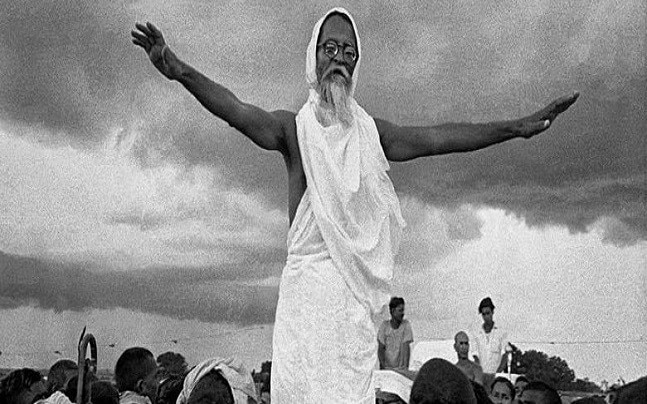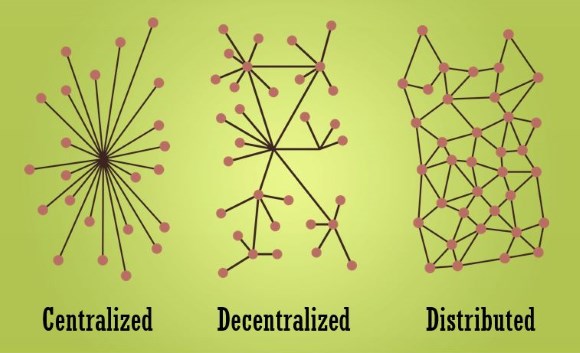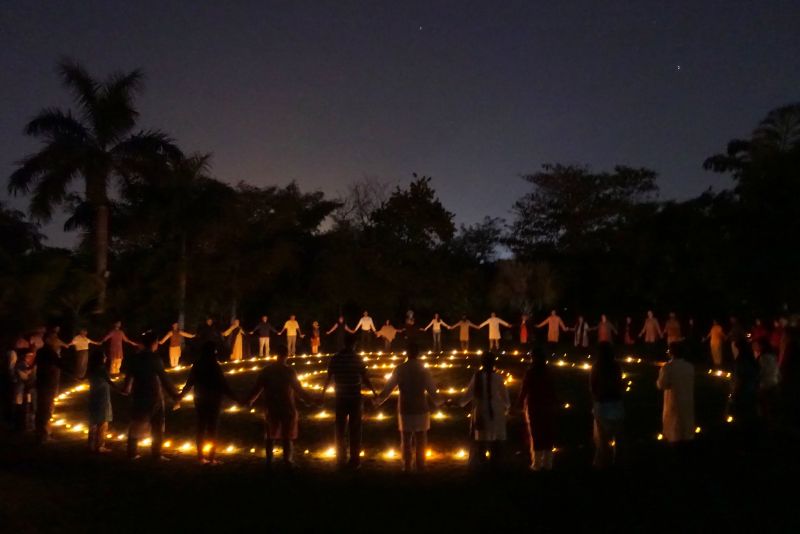Gandhi And ServiceSpace
[Some reflections based on a recent conversation on how Gandhi and ServiceSpace are connected.]
In many ways, ServiceSpace shares great affinities with Gandhian values. While ServiceSpace founders, in their early twenties and younger, didn’t explicitly aim to emulate Gandhi nor were they well-versed in his philosophy at the time, decades of subsequent work has shown a rather striking affinity to shared values that Gandhi referred to as “old as hills.”

At its core, Gandhi’s organizing principle was to “be the change” and trust in the ripple effect. This has been the ServiceSpace credo from its start in April 1999.
Originally, ServiceSpace was building websites for nonprofits. Thousands of nonprofits were served, and as technology evolved, its services turned into web portals and eventually a slew of other online and offline projects. The underlying story, though, is significant. In the dot-com hey-day, ServiceSpace’s young volunteers went entirely against the grain to be the change. They wanted to serve purely in the spirit of inner transformation, and that meant seeking nothing in return. No charges, no fundraising, no advertising, no pitching stories to media. No agenda at all. Just sincere service. That sounds almost like an innocent lemonade stand, but twenty years later, despite various lucrative offers to scale, it has stayed in deep integrity with its three guiding values. That's not only proved to be radical but now has become a benchmark for many enterprises and movements.
Gandhi unapologetically felt that anything that was built on the foundation of markets and military would ultimately propagate violence. Yet, today’s society is hard-pressed to find voluntary and beyond-market examples of sustained social change. Not only are such visions discarded as “utopian”, they are often criticized as pacifiers for preserving the status quo. Indeed, even times of Gandhi, Ambedkar would call this “tyranny of incrementalism.” ServiceSpace, however, was born in the times of networks, and we didn’t equate ripple effect with incrementalism; they knew, as did the whole post-Internet world, about the non-linearity of networks. The entire commercial world has been upended by exponential network effects, just as we have seen unprecedented large-scale protests that toppled governments.
What the Internet delivered for profit and protest, ServiceSpace aimed to do for love -- for “Ahimsa”.

Vinoba Bhave, for whom Gandhi had the highest respect, shared that Gandhi didn’t have time to expound on Ahimsa during his lifetime; but he defined it as not merely as the absence of violence but as a pro-active force of “prem” and “karuna” -- love and compassion. Because any form of coercion (government military) or extrinsic motivation (money) lowered the ceiling of that emergence, it was to be used as the very last resort. Repeatedly, we see examples of this in Vinoba’s work. As a design principle, then, Ahimsa invites us to think beyond these base forces. Indeed, Gandhi himself noted that he had more faith in the “law of love” than the law of gravity!
ServiceSpace has given wings to the idea of Law of Love by inspiring volunteerism through small acts of service, leveraging the Internet to connect these acts in a malleable and dynamic field, and uncorking the intelligence of larger labor of love movement. Millions of hours of service have been rendered by ServiceSpace volunteers worldwide, but what’s particularly innovative is that it created feedback loops that allowed volunteers to seamlessly expand into project initiators. They call this Gandhi 3.0. If Gandhi 1.0 is the one-to-many broadcast model of operation, and Gandhi 2.0 is the one-to-one network that Vinoba Bhave lived into, it is Gandhi 3.0 that parallels the many-to-many possibility of the Internet era -- except, this time, it wasn’t for profit or protest, but for the Law of Love.
In this ServiceSpace ecosystem, millions of micro-interactions happen every day -- online and offline. Organically, they connect, disconnect, reconnect, synergize, multiply. It has an intelligence, or a flow, of its own. At one meeting, someone wondered, “What would happen if we ran a restaurant where everyone’s bill was zero, and they were trusted to pay-forward what they for the person after them?” A closed feedback-loop to showcase the power of indirect reciprocity. Two weeks later, Karma Kitchen was started as an experiment. It spread rapidly. Now, hundreds of thousands have experienced it, in 23 countries. Celebrities tweeted about it. History Channel created a short film, which went viral and spread to tens of millions. At UC Berkeley’s business school, they scrutinized the payment process with academic rigor and issued a seminal paper titled, “Paying More When Paying For Others.” It was replicated in all kinds of contexts, from a gift-economy rickshaw on the streets of India to a yoga studio in Hollywood. All such ripples further cultivate the entire field.
As the father of a nation, Gandhi proved to be a master communicator and coined many new words -- so he could tell a new story.
 Similarly, ServiceSpace has needed a new vocabulary to holds its narratives. In place of activism that classifies the opponent as the enemy, giftvism speaks to the upliftment of 100%. To expand our lens beyond money, we assess value in the context of “multiple forms of wealth”. Replacing hierarchy with circles still creates an in-circle and out-circle divide; to circumvent this, we talk about mobiosity with interchangeable seats. In an Instagram culture of rapid selfies, we invite “slow stories”. To upgrade a sharing economy, and even a gift economy, we speak about a vastly richer gift ecology. If leadership is about leveraging transactions to accumulate power and deliver on pre-meditated destinations, “Laddership” is about riding the flow to support the emergence.
Similarly, ServiceSpace has needed a new vocabulary to holds its narratives. In place of activism that classifies the opponent as the enemy, giftvism speaks to the upliftment of 100%. To expand our lens beyond money, we assess value in the context of “multiple forms of wealth”. Replacing hierarchy with circles still creates an in-circle and out-circle divide; to circumvent this, we talk about mobiosity with interchangeable seats. In an Instagram culture of rapid selfies, we invite “slow stories”. To upgrade a sharing economy, and even a gift economy, we speak about a vastly richer gift ecology. If leadership is about leveraging transactions to accumulate power and deliver on pre-meditated destinations, “Laddership” is about riding the flow to support the emergence.
Such new constructs help architect new stories. Ragu and Nisha left Silicon Valley to farm in Coimbatore. Graduating from college as a valedictorian, Zilong went on a 30 thousand mile bicycling pilgrimage and now serves at a nunnery in China. After drafting Iraqi constitution and Afghani constitution as Obama’s general counsel, Preeta finds great meaning in "small acts of kindness" and hosting Awakin Circles in her home town in Nebraska. Former UC Berkeley PhD student walked for 93 days to plant a One-Earth flag on US-Mexico border. At a recent international conference, Audrey launched “unTickets” where admission could also come with kind acts, meditation, creative expressions and volunteer hours. On Wall Street, when Birju was billing every three minutes, he pioneered a minute of silence at the start of his weekly team meeting. Hip-hop rapper named Nimo started to popularize songs of kindness and gratitude. Richard, an art magazine editor for 15 years, took away all dollars signs from his magazine to only accept offerings of gratitude. These are but a handful of numerous life-transforming stories that span the globe.
From a Gandhian lens, a big risk for any successful movement is to hold it all under one umbrella, one monolithic organization. “Accumulation of wealth is accumulation of sin” for Gandhi, whether that wealth is money or people or influence. True to his aspirations, he passed away with a handful of possessions, no property, no official title or office. When Vinoba received 5 million acres of donated land, he didn’t accumulate it under the auspices of redistributing it with the intelligence of "experts". He just lit the fire in the hearts of people and trusted their judgment to self organize appropriately. Both Gandhi and Vinoba repeatedly favored decentralized designs, because they saw all life as a potential channel for greater genius to flow through. In place of a centralized core that is prone to corruption, they found wisdom in the resiliency of distributed power -- a precise mirror of our inner and outer nature.
Likewise, Servicespace aims to design decentralized and distributed systems. For instance, in a living room in California, few people came together to sit in silence for an hour, share aha-moments of the week in the second hour, and enjoy a meal offering in the third hour. After a decade, those circles came to be known as “Awakin Circles”. No teachers, no donation box, nothing to belong to. Barrier to entry was minimal, as was the barrier to exit. Over the last 20 years, more than 45 thousand people have been fed in that living room alone, some of whom went on to start their own local circles! Today, Awakin Circles take place in 100 places around the world, but because it is decentralized, it’s true impact is hard to capture. We continue to be surprised every day. :)
 With such an approach, however, it is easy to imagine the “impact” of ServiceSpace is unknown. Every so often, we do come up with “McDonalds Numbers” but it’s real effect would be impossible to calculate. In fact, it would feel arrogant to claim singular credit even for all that we can measure. So, when someone asks, “What’s the impact of ServiceSpace?”, our counter-question is, “Why does that matter?” Instead of being motivated by the scale and impact of ServiceSpace, we’d rather lead with inner transformation. That is to say, our response to the impact question would be, “Let’s do a simple act of kindness for anyone anywhere, and see where that leads.” If that road leads back to ServiceSpace, that’s great. If not, that’s just as fantastic.
With such an approach, however, it is easy to imagine the “impact” of ServiceSpace is unknown. Every so often, we do come up with “McDonalds Numbers” but it’s real effect would be impossible to calculate. In fact, it would feel arrogant to claim singular credit even for all that we can measure. So, when someone asks, “What’s the impact of ServiceSpace?”, our counter-question is, “Why does that matter?” Instead of being motivated by the scale and impact of ServiceSpace, we’d rather lead with inner transformation. That is to say, our response to the impact question would be, “Let’s do a simple act of kindness for anyone anywhere, and see where that leads.” If that road leads back to ServiceSpace, that’s great. If not, that’s just as fantastic.
Such a liberating expansive-ness is an ode to ServiceSpace organizing principles and its long-standing commitment to it.
When we don’t lead with impact, we invite deeper engagement. Over time, a web of multi-dimensional relationships creates a field of transformation -- in which compassion arises. Gandhi was decidedly rooted in tilling that kind of soil. In 1922, in Chauri Chaura, when freedom fighters in India “won” a violent show-down with the police, Gandhi shut down the entire movement for a week and opted to work another 25 long years to build a field that was ripe for transformation. For Gandhi, that field and its subsequent awakening of compassion, was far more important than a strategic maneuver to secure independence for India.
Most historians would suggest that Gandhi created the movement. From a meta-lens, though, the movement is also what created Gandhi. Gandhi builds the field, and the field builds Gandhi. It’s mutually reinforcing. Yet, it’s hard to delineate if a particular act of service is building the field or building you. Holding that insight compels us to release outcomes of one’s action into a far longer timeline, even if it is multi-generational. In Gandhi’s case, he was able to see outcomes in his lifetime, but he would’ve done the same thing even if he didn’t. At a recent Awakin Circle in London, Gandhi’s grandson, Rajmohan Gandhi, reflected, “Gandhi was always on the give. People around him were mostly takers but that didn’t disturb Gandhi. He kept giving.” That was the backbone for all his work.
Over time, ServiceSpace has also become an emblem for principled generosity. In letting go, you also let in. Without any solicitation. In the recent past, Dalai Lama has honored ServiceSpace; President Obama invited us on a prestigious panel for advice on addressing poverty and inequality in America; royalty from Japan attended one of our retreats; vice-president at SAP is modeling his movement of people with “disabilities” after ServiceSpace; a Rockefeller offered an unsolicited and unrestricted donation to ServiceSpace; a Nobel Peace Laureate attended our six-week “Laddership Circle” and added with tears, “I don’t want this to end.” Religious leaders from so many faiths fondly appreciate ServiceSpace as an exemplary effort, reputed social entrepreneurs integrate our values into their organizations, deeply respected Gandhians offer their whole-hearted blessings onto the whole ecosystem. Despite having very little, a whole lot of abundance keeps coming in the direction of ServiceSpace. If transaction is direct reciprocity, and circles invite indirect reciprocity, perhaps this is nature’s reciprocity. It’s hard to say, but like Gandhi, our plan is to just keep serving.

For a casual observer, Gandhian action is depicted by “satyagraha” -- an opposition to injustice. However, Gandhi also clearly stated that 10% of action can be satyagraha when 90% is “constructive program”. Without that foundation of a constructive program, the 10% simply won’t be effective. Vinoba Bhave, who was named as an exemplary Satyagrahi by Gandhi, shared that if a satyagraha doesn’t work, we must be mindful to not head in the direction of greater coercion. Instead, we must make our actions gentler. Subtler. And if the subtler satyagraha doesn’t work, we must get even “gentlier and gentliest”.
This is perhaps the call of the hour. In the face of repeated failures of overt satyagraha, from climate change to inequality to autocracies, we need to cultivate an ecosystem of beyond-market and beyond-government solutions that can authentically hold a gentler and subtler satygraha and sustainably uplift all life.
If we consider the metaphor of a polluted farm, it would take several years to convert it to a regenerative organic field. However, we have created subversive systems where that patience feels like a luxury we can’t afford. The yields need to be harvested sooner, and sooner. Almost immediately. Similarly, in the social sphere, that narrowing feedback loop is suffocating our potential for compassion, for Ahimsa. Even systems like the design of money itself are adept at narrowing our circle of concern. In fact, it has become so narrow that we sometimes forget to include parts of our own self in that sphere. Today, more people are dying of suicide than violent deaths. Turning all that around is a gargantuan challenge -- of providing some short-term relief without compromising long-term solutions. Audre Lorde once said, "Master’s tools will never dismantle the master’s house." The question then becomes -- what exactly is the master’s house, and what are the master’s tools? Buddha's response would be dramatically different than a traditional activist, but Gandhi's genius lay in bridging the depth of spirituality with social change.
Living in an increasingly complex world, with pernicious reward mechanisms, will likely require many of us to try many different experiments, many different longshots. ServiceSpace is but one of them.

It's hard to know what exactly Gandhi would do today, but like him, ServiceSpace leads with inner transformation. Be the change. We trust in the ripple effect, and by bridging the internet with the inner-net, we unlock an exponential network effect. Without any advertising, or fundraising. Aligned with Gandhian thinking, ServiceSpace is a pioneering example of a sustained movement that operates outside of government or market forces. We double down on intrinsic motivations, which helps build bridges across all sectors of society. Our wide reach self organizes itself into decentralized communities of practice that span dozens of countries. Scale is merely an externality, not an organizing principle. What matters most is that everyone is seen as a potential change-maker because everyone can give. Gandhi 3.0, we call it. A new vocabulary helps us tell these uncommon stories about new heroes. By resisting the temptation to design for immediate impact, we shift from transaction to relationships to transformation to compassion -- which then builds a field of deep ties, and manifests uncommon change in the world. :)
In honoring the small and the subtle, optimizing for non-financial expressions of wealth, and holding a very long timeline, ServiceSpace can experientially validate Gandhi's profound insight: “In a gentle way, we can shake the world.”
Posted by Nipun Mehta on Jul 14, 2019
SHARE YOUR REFLECTION
12 Past Reflections


On Jul 14, 2019 Pancho Ramos Stierle wrote:
Not a trivial thing to articulate all this, that could be so easily felt on an Awakin Circle at the Kindness Temple and now in so many other homes.
As am writing this comment from Tijuana, the tickle of translating the power and depth of this message cropped up... let's see how far we can translate this great Jai Jagat piece!

On Jul 17, 2019 Ariel Nessel wrote:
Within this valuable treatise, I especially enjoyed the concept that ahimsa is a core value of ServiceSpace. I can see the prominence of this wisdom becoming more and more prominent within our shared activities, much the same as mindfulness is a grounding of the "how" in which we engage.
There are so many opportunities for me to pay forward the blessings life continues to offer. For some reason, there is no group of people I feel more called to do that with than those within this ecosystem ðŸ™ðŸ™ðŸ™.

On Jul 18, 2019 Parag Shah wrote:

On Jul 18, 2019 Sunil, Bangalore wrote:

On Jul 18, 2019 ram gada wrote:
We wish you the success. We are trying our best in Minnesota, started with Exhibit at the Festival of Nations (100 ethnic communities celebration), Essay Contest for Minnesota High school students, Walk for Peace on September 21 to the Capitol and celebration of his birthday on September 29 at the Minnesota History Center.We hope you can join and inspire us on September 29.Peace,Peace,Peace.

On Jul 18, 2019 Aryae Coopersmith wrote:

On Jul 18, 2019 Chris Johnnidis wrote:

On Jul 18, 2019 Rajalakshmi Sriram wrote:
What a delight to engage with this reflective write up.
These thoughts linger on ....
" from climate change to inequality to autocracies, we need to cultivate an ecosystem of beyond-market and beyond-government solutions that can authentically hold a gentler and subtler satygraha and sustainably uplift all life".
Hope we can reach out with our 'true selves' to ripple out more smiles through inner-nets

On Jul 18, 2019 Rohit Rajgarhia wrote:
I guess this is due to commitment to inside-out change.
And, servicespace brought alive gandhi and vinoba and the underlying values, in a way which I find very relevant in my day-to-day life, which I could never have grasped myself from their common portrayal in popular history books. :-)

On Nov 17, 2019 PRAGNESH PANCHAL wrote:
I WILL BE HAPPY TO BE A PART OF YOUR GROUP AS WELL.
BEST OF LUCK.





On Jul 14, 2019 Rohan Bhansali wrote:
One may not be able to soundbite or calculate the impact of ServiceSpace just as one cannot calculate the impact of the Sun. But like the Sun, it doesn't care to tangibilise it. It just shines because that’s its nature.
Post Your Reply